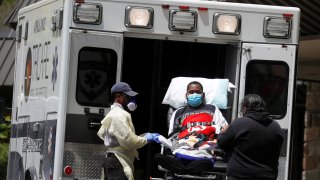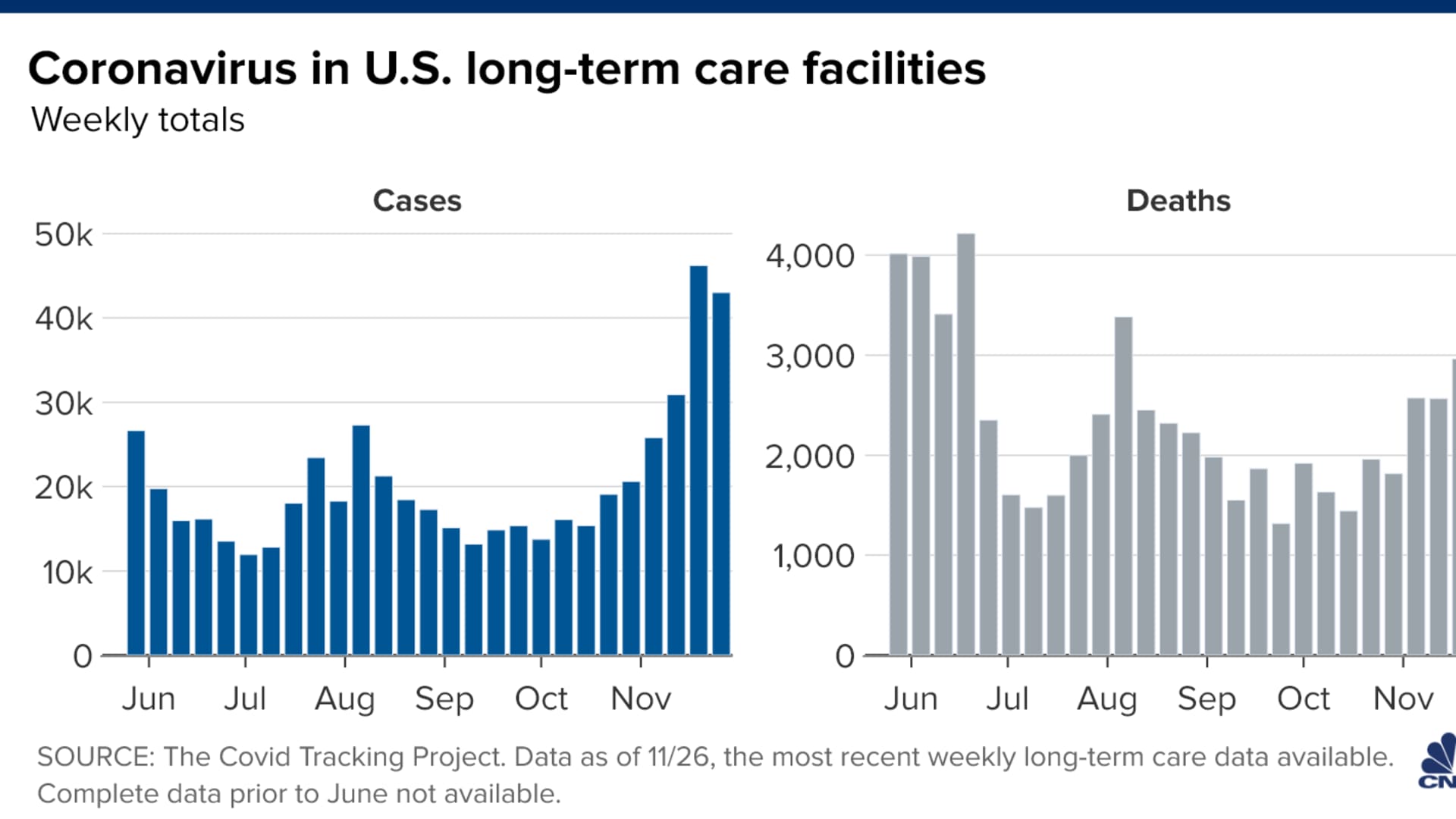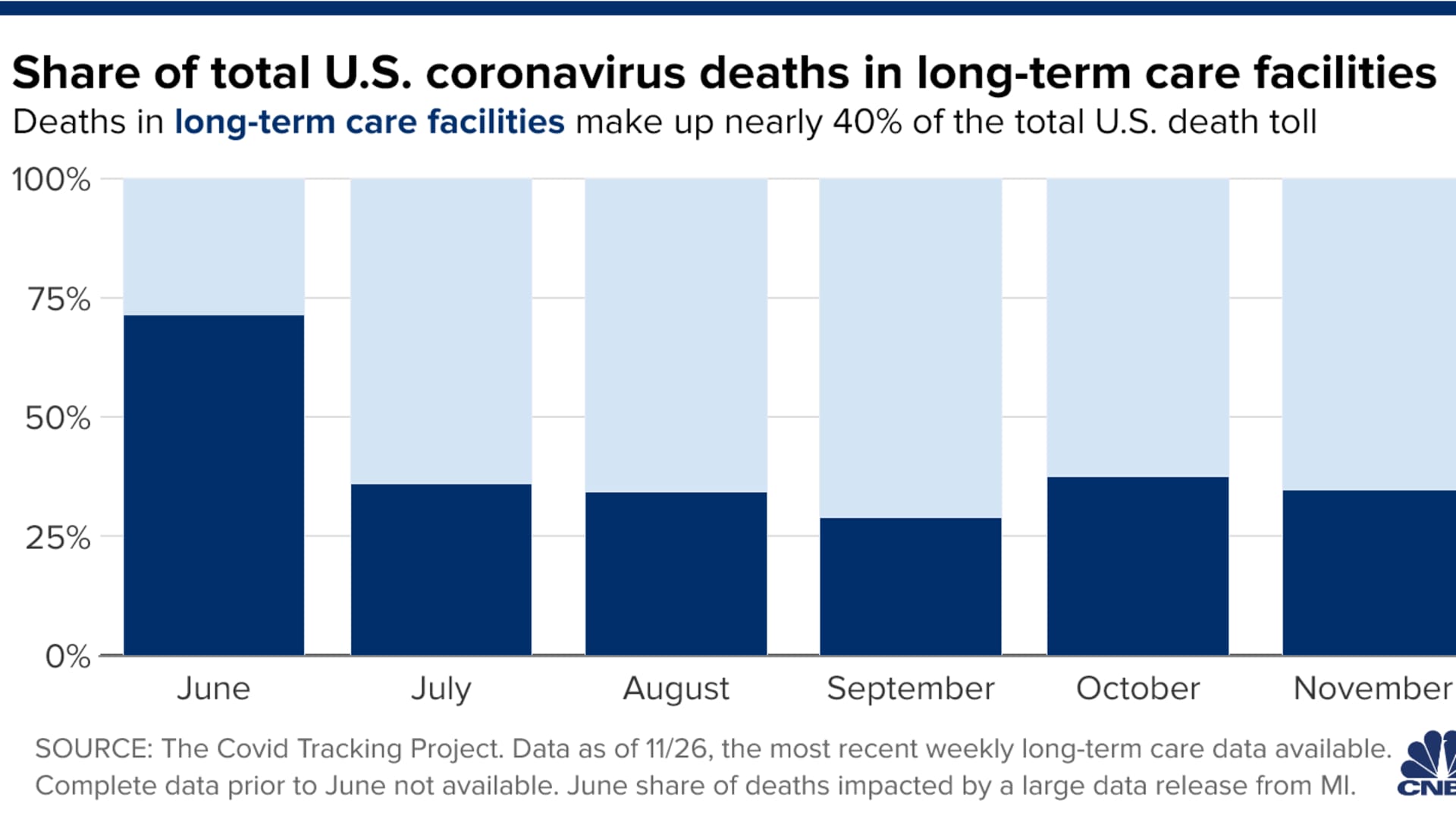
- Nursing homes, which house the most vulnerable of society, quickly became ground zero for countless coronavirus outbreaks across the U.S. in the early months of the pandemic.
- While the outbreak subsided somewhat this fall, long-term care facilities are now seeing their most intense surge in Covid cases since the summer.
- As new cases break record after record most days, infections at long-term care facilities reached a new weekly high in late November.

The coronavirus death toll at U.S. nursing homes at the beginning of the coronavirus pandemic was brutal and unrelenting.
The Life Care Center nursing home outside Seattle made international headlines in March after the coronavirus infected residents and staff, resulting in at least 123 cases and dozens of deaths. In New Jersey, public officials discovered 17 bodies piled into a makeshift morgue in a nursing home in April when Covid-19 fatalities overwhelmed the facility.
Nursing homes, which house the most vulnerable of society, quickly became ground zero for countless coronavirus outbreaks across the U.S. in the early months of the pandemic. While the outbreak subsided somewhat this fall, long-term care facilities are now seeing their most intense surge in Covid cases since at least the summer.
As new cases break record after record most days, infections at long-term care facilities reached a new weekly high in late November, according to data from the COVID Tracking Project, an organization launched by The Atlantic magazine. More than 46,000 infections at those facilities were recorded in what was the worst week in six months; reliable data only goes back that far.
Despite making up just 5.7% of all U.S. Covid cases, nursing home and assisted living facilities residents and staff accounted for 39.3% of the deaths, according to tracking project data. That number is generally considered low since many nursing home deaths tend to get reported without an underlying cause, physicians have said.
Money Report
Deaths at U.S. nursing homes for the week ended last Thursday topped 3,000 — the highest weekly death toll since June, pushing cumulative fatalities over 100,000, according to the tracking project.
"I've likened nursing homes to being like a tinderbox. It takes one person, one person, to unknowingly bring the virus into a facility and it could kill several people, make a lot of people sick," said Dr. Joseph Ouslander, a geriatrician at Florida Atlantic University who works as a clinician in nursing homes. No matter what precautions staff take, it's going to be difficult to prevent outbreaks in nursing homes, said Ouslander, who is also a professor of integrated medical science. "All those elements of the perfect storm are in place."
An advisory panel to the Centers for Disease Control and Prevention voted 13-1 Tuesday to give the first vaccine doses in the nation to health-care workers and long-term care facility residents.

That's why controlling spread in the outside community is among the most important line of defense in protecting long-term care residents, according to Ouslander and other researchers.
"We can't stop the nursing home cases and deaths unless we stop community spread," said Tamara Konetzka, a University of Chicago professor who specializes in long-term care research.
Community spread in the U.S. is rampant right now. New cases have been growing across the country at a rapid clip this fall, with Covid-19 hospitalizations currently rising by 5% or more over the last week in 38 states, according to a CNBC analysis of the most recent COVID Tracking Project data. There have been more than 13.7 million confirmed U.S. coronavirus cases, with at least 270,000 deaths so far, according to Hopkins data.
Of the 46 states and the District of Columbia for which long-term care data was regularly reported over the past two months, cases are on the rise in 44 of them.

The data also includes assisted living facilities, which are similarly at risk of having outside staff potentially bring the virus inside, said Sheryl Zimmerman, co-director of Program on Aging, Disability, and Long-Term Care at the University of North Carolina at Chapel Hill's Center for Health Services Research. However, Zimmerman said that assisted living residents, while often elderly, are generally in better health than those in nursing homes.
In both types of long-term facilities, residents are older. More than half of residents in assisted living facilities are 85 or older, Zimmerman said. More than 80% of nursing home residents are over age 65, according to a 2015 Centers for Medicare and Medicaid Services report.
That demographic is particularly vulnerable to getting Covid — and dying from the virus. The CDC says the rate of deaths due to Covid among those 75 to 84 years old is 220 times higher than for those ages 18 to 29. For those 85 and older, the rate is 630 times higher.
Improvements have been made
If the experience of Gold Crest Retirement Center in Adams, Nebraska, is any indication, the rise in coronavirus cases inside long-term care facilities this fall could be even worse.
Gold Crest was one of the first facilities in Nebraska to record a case of Covid in the spring, Executive Director Jeff Fritzen told CNBC. Gold Crest ended up with 20 cases, 12 in its assisted living unit and eight in its nursing home. Three residents died in those early months.
"When we had our outbreak in April here at Gold Crest, Covid was kind of unheard of in the area," said Fritzen, whose rural facility is about 30 miles south of Lincoln, the state capital.
Gage County, which is home to Adams, now has over 1,200 confirmed cases out of roughly 21,500 people. Gold Crest has managed to protect its residents from Covid — even though more than a dozen staff members have tested positive in the last three months, Fritzen said. They haven't had a single positive coronavirus case in a resident since April. He credits weekly Covid-19 testing using rapid kits provided by the government, broader access to N95 masks and other protective gear. That has given them a crucial layer of protection in case a staff member who is infected does end up working a shift.
"I think the testing has been a game changer," Fritzen said. "We're able to identify staff members that have it and get them out of the building. We're able to test you on symptom. We're able to test you if get exposed."
While diagnostic testing and personal protective equipment are generally more available now than earlier in the pandemic, they're hardly uniform across the country. "It's all over the map," Konetzka said.
"The problem is, it only takes one," Fritzen said. "It takes one staff member to bring the virus into the building, and it's just trouble."






